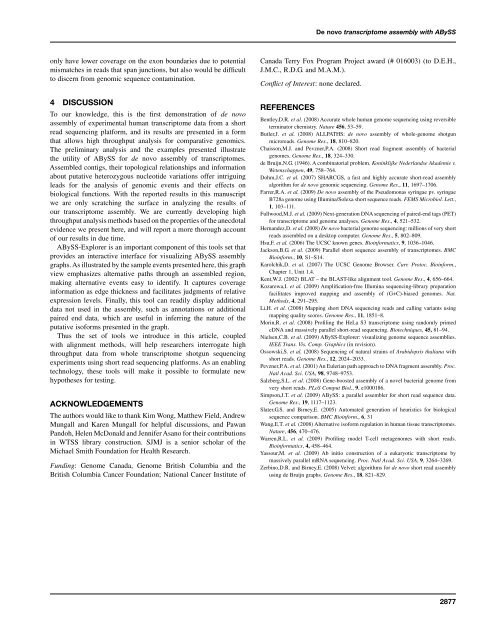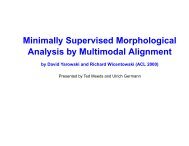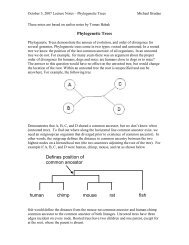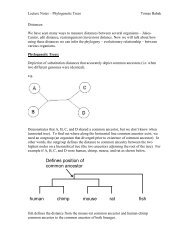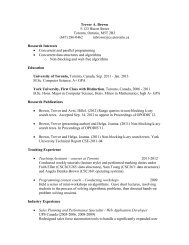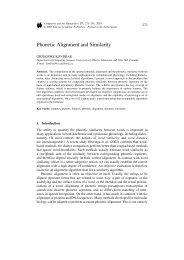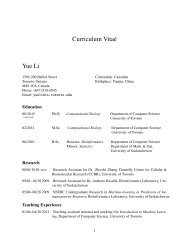De novo transcriptome assembly with ABySS - Bioinformatics
De novo transcriptome assembly with ABySS - Bioinformatics
De novo transcriptome assembly with ABySS - Bioinformatics
You also want an ePaper? Increase the reach of your titles
YUMPU automatically turns print PDFs into web optimized ePapers that Google loves.
only have lower coverage on the exon boundaries due to potential<br />
mismatches in reads that span junctions, but also would be difficult<br />
to discern from genomic sequence contamination.<br />
4 DISCUSSION<br />
To our knowledge, this is the first demonstration of de <strong>novo</strong><br />
<strong>assembly</strong> of experimental human <strong>transcriptome</strong> data from a short<br />
read sequencing platform, and its results are presented in a form<br />
that allows high throughput analysis for comparative genomics.<br />
The preliminary analysis and the examples presented illustrate<br />
the utility of <strong>ABySS</strong> for de <strong>novo</strong> <strong>assembly</strong> of <strong>transcriptome</strong>s.<br />
Assembled contigs, their topological relationships and information<br />
about putative heterozygous nucleotide variations offer intriguing<br />
leads for the analysis of genomic events and their effects on<br />
biological functions. With the reported results in this manuscript<br />
we are only scratching the surface in analyzing the results of<br />
our <strong>transcriptome</strong> <strong>assembly</strong>. We are currently developing high<br />
throughput analysis methods based on the properties of the anecdotal<br />
evidence we present here, and will report a more thorough account<br />
of our results in due time.<br />
<strong>ABySS</strong>-Explorer is an important component of this tools set that<br />
provides an interactive interface for visualizing <strong>ABySS</strong> <strong>assembly</strong><br />
graphs. As illustrated by the sample events presented here, this graph<br />
view emphasizes alternative paths through an assembled region,<br />
making alternative events easy to identify. It captures coverage<br />
information as edge thickness and facilitates judgments of relative<br />
expression levels. Finally, this tool can readily display additional<br />
data not used in the <strong>assembly</strong>, such as annotations or additional<br />
paired end data, which are useful in inferring the nature of the<br />
putative isoforms presented in the graph.<br />
Thus the set of tools we introduce in this article, coupled<br />
<strong>with</strong> alignment methods, will help researchers interrogate high<br />
throughput data from whole <strong>transcriptome</strong> shotgun sequencing<br />
experiments using short read sequencing platforms. As an enabling<br />
technology, these tools will make it possible to formulate new<br />
hypotheses for testing.<br />
ACKNOWLEDGEMENTS<br />
The authors would like to thank Kim Wong, Matthew Field, Andrew<br />
Mungall and Karen Mungall for helpful discussions, and Pawan<br />
Pandoh, Helen McDonald and Jennifer Asano for their contributions<br />
in WTSS library construction. SJMJ is a senior scholar of the<br />
Michael Smith Foundation for Health Research.<br />
Funding: Genome Canada, Genome British Columbia and the<br />
British Columbia Cancer Foundation; National Cancer Institute of<br />
<strong>De</strong> <strong>novo</strong> <strong>transcriptome</strong> <strong>assembly</strong> <strong>with</strong> <strong>ABySS</strong><br />
Canada Terry Fox Program Project award (# 016003) (to D.E.H.,<br />
J.M.C., R.D.G. and M.A.M.).<br />
Conflict of Interest: none declared.<br />
REFERENCES<br />
Bentley,D.R. et al. (2008) Accurate whole human genome sequencing using reversible<br />
terminator chemistry. Nature 456, 53–59.<br />
Butler,J. et al. (2008) ALLPATHS: de <strong>novo</strong> <strong>assembly</strong> of whole-genome shotgun<br />
microreads. Genome Res., 18, 810–820.<br />
Chaisson,M.J. and Pevzner,P.A. (2008) Short read fragment <strong>assembly</strong> of bacterial<br />
genomes. Genome Res., 18, 324–330.<br />
de Bruijn,N.G. (1946). A combinatorial problem. Koninklijke Nederlandse Akademie v.<br />
Wetenschappen, 49, 758–764.<br />
Dohm,J.C. et al. (2007) SHARCGS, a fast and highly accurate short-read <strong>assembly</strong><br />
algorithm for de <strong>novo</strong> genomic sequencing. Genome Res., 11, 1697–1706.<br />
Farrer,R.A. et al. (2009) <strong>De</strong> <strong>novo</strong> <strong>assembly</strong> of the Pseudomonas syringae pv. syringae<br />
B728a genome using Illumina/Solexa short sequence reads. FEMS Microbiol. Lett.,<br />
1, 103–111.<br />
Fullwood,M.J. et al. (2009) Next-generation DNA sequencing of paired-end tags (PET)<br />
for <strong>transcriptome</strong> and genome analyses. Genome Res., 4, 521–532.<br />
Hernandez,D. et al. (2008) <strong>De</strong> <strong>novo</strong> bacterial genome sequencing: millions of very short<br />
reads assembled on a desktop computer. Genome Res., 5, 802–809.<br />
Hsu,F. et al. (2006) The UCSC known genes. <strong>Bioinformatics</strong>, 9, 1036–1046.<br />
Jackson,B.G. et al. (2009) Parallel short sequence <strong>assembly</strong> of <strong>transcriptome</strong>s. BMC<br />
Bioinform., 10, S1–S14.<br />
Karolchik,D. et al. (2007) The UCSC Genome Browser. Curr. Protoc. Bioinform.,<br />
Chapter 1, Unit 1.4.<br />
Kent,W.J. (2002) BLAT – the BLAST-like alignment tool. Genome Res., 4, 656–664.<br />
Kozarewa,I. et al. (2009) Amplification-free Illumina sequencing-library preparation<br />
facilitates improved mapping and <strong>assembly</strong> of (G+C)-biased genomes. Nat.<br />
Methods, 4, 291–295.<br />
Li,H. et al. (2008) Mapping short DNA sequencing reads and calling variants using<br />
mapping quality scores. Genome Res., 11, 1851–8.<br />
Morin,R. et al. (2008) Profiling the HeLa S3 <strong>transcriptome</strong> using randomly primed<br />
cDNA and massively parallel short-read sequencing. Biotechniques, 45, 81–94.<br />
Nielsen,C.B. et al. (2009) <strong>ABySS</strong>-Explorer: visualizing genome sequence assemblies.<br />
IEEE Trans. Vis. Comp. Graphics (in revision).<br />
Ossowski,S. et al. (2008) Sequencing of natural strains of Arabidopsis thaliana <strong>with</strong><br />
short reads. Genome Res., 12, 2024–2033.<br />
Pevzner,P.A. et al. (2001) An Eulerian path approach to DNA fragment <strong>assembly</strong>. Proc.<br />
Natl Acad. Sci. USA, 98, 9748–9753.<br />
Salzberg,S.L. et al. (2008) Gene-boosted <strong>assembly</strong> of a novel bacterial genome from<br />
very short reads. PLoS Comput Biol., 9, e1000186.<br />
Simpson,J.T. et al. (2009) <strong>ABySS</strong>: a parallel assembler for short read sequence data.<br />
Genome Res., 19, 1117–1123.<br />
Slater,G.S. and Birney,E. (2005) Automated generation of heuristics for biological<br />
sequence comparison. BMC Bioinform., 6, 31<br />
Wang,E.T. et al. (2008) Alternative isoform regulation in human tissue <strong>transcriptome</strong>s.<br />
Nature, 456, 470–476.<br />
Warren,R.L. et al. (2009) Profiling model T-cell metagenomes <strong>with</strong> short reads.<br />
<strong>Bioinformatics</strong>, 4, 458–464.<br />
Yassour,M. et al. (2009) Ab initio construction of a eukaryotic <strong>transcriptome</strong> by<br />
massively parallel mRNA sequencing. Proc. Natl Acad. Sci. USA, 9, 3264–3269.<br />
Zerbino,D.R. and Birney,E. (2008) Velvet: algorithms for de <strong>novo</strong> short read <strong>assembly</strong><br />
using de Bruijn graphs. Genome Res., 18, 821–829.<br />
2877


